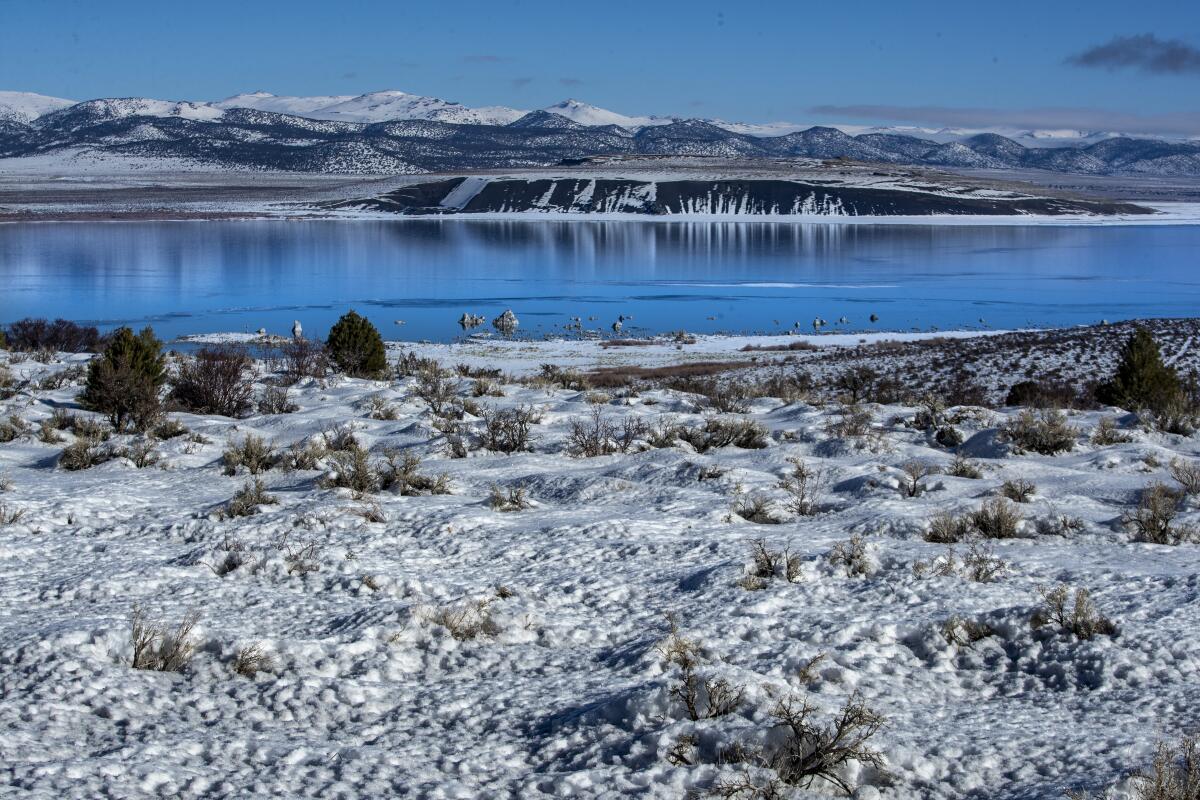How Disney is using ‘Star Wars’ to help Chevy sell electric cars
- Share via
This is the Feb. 25, 2021, edition of Boiling Point, a weekly newsletter about climate change and the environment in California and the American West. Sign up here to get it in your inbox.
If you’ve been on the internet this month, you may have seen the General Motors ad that aired during the Super Bowl. It features a bearded Will Ferrell putting his fist through a globe out of frustration that Norway sells more electric cars per person than the United States, then rounding up Kenan Thompson and Awkwafina to help him take on the Norwegians.
Much as that made me laugh, I was even more enamored of the Chevrolet ad that debuted during “American Idol” last week.
The 90-second commercial promotes the company’s new Bolt EUV, basically an electric SUV. It was partially filmed at Walt Disney World and includes characters and motifs from “Star Wars,” “Peter Pan” and a whole lot else. The tagline: “Magic is electric.”
Granted, I am an enormous Disney Parks fan. So of course I loved seeing the Haunted Mansion’s hitchhiking ghosts catching a ride with unsuspecting road-trippers, and Han Solo’s Millennium Falcon soaring over the entrance to Disney World.
Really, though, what caught my attention was seeing the world’s most influential storytelling machine — a company that caters to people across the political spectrum — lending some of its most iconic brands to the clean energy transition.
Toward a more sustainable California
Get Boiling Point, our newsletter exploring climate change, energy and the environment, and become part of the conversation — and the solution.
You may occasionally receive promotional content from the Los Angeles Times.
To be clear, Disney and the automaker are motivated primarily by shareholder profits, not saving the planet. I’m sure Chevy, which is owned by General Motors, paid Disney handsomely for its services. And although GM announced plans last month to stop selling passenger vehicles that run on gasoline by 2035, as recently as November the company was still fighting California’s authority to set its own clean-air standards, only to change course after realizing Joe Biden would be the next president.
More broadly, there are plenty of reasons to be skeptical of corporate climate pledges. As Peter Eavis and Clifford Krauss report for the New York Times this week, many of the companies making those pledges have not set firm emissions reductions targets, and even those that have are sometimes not meeting them.
But however much climate credit you give General Motors, its recent ads are a powerful example of the type of climate-positive creative work that a growing number of marketing and design professionals want to be doing.
I spoke recently with Jamie Henn, founder of the advocacy group Fossil Free Media. He’s been in the climate trenches a long time — he co-founded 350.org with Bill McKibben in 2007 — and he’s watched public relations firms and ad agencies do the (lucrative) bidding of the fossil fuel industry. He’s slowly come to see this bidding as a major obstacle to sustained climate action.
So last year he launched a campaign, Clean Creatives, to pressure PR and advertising executives to stop working with coal, oil and gas companies. The campaign released a report in December highlighting the many agencies that have served fossil fuel clients in recent years, from Edelman’s “Vote 4 Energy” campaign for the American Petroleum Institute, to FTI Consulting’s messaging work for the oil and gas industry, to BBDO’s video ads touting ExxonMobil’s clean-fuels research.
Clean Creatives found that the fossil fuel industry spent at least $1 billion on public relations and advertising from 2014 through 2018. Looking at trade associations specifically, groups representing coal, oil and gas companies spent $439 million during those years, the report found, compared with just $1 million for the two main solar and wind energy groups.
Henn thinks the renewable energy industry needs to take a page from the fossil fuel playbook — not just by spending more money promoting itself, but by taking a close look at how its climate-disrupting competitors have convinced people their products are a bedrock of American society. If you watch enough coal, oil and gas company ads, Henn said, “you quickly realize there’s a lot of American flags, and there’s a lot of people in hard hats, and that’s intentional.”
“The fossil fuel industry has spent 100 years wrapping themselves in the American flag and claiming to be the greatest economic engine ever known to man,” he said. “I live here in Utah, and coal is our state rock. People don’t realize that there are more people working in energy efficiency and solar than there are in the fossil fuel sector. And that blows people’s minds.”
So there’s a positive story to tell. And it depends in large part on creative professionals.
“They shape our perception of the reality around us,” Henn said.
Sarah Harrison and Marc O’Brien, who run Bay Area creative studio the Determined, have been thinking about how they and their colleagues can contribute to tackling the climate crisis. In 2019, they co-founded Climate Designers to bring together designers of all kinds — graphic designers, web designers, fashion designers, industrial designers — and encourage them to think hard about who they’re working for, what messages they’re sending and what kinds of products they’re developing.
“We are involved in a lot of the decisions about how something is created, what it’s made out of, where it gets its materials from, what happens to it when people are done with it, how it gets used,” Harrison said.
Climate Designers now has nine chapters, including one in Los Angeles. The group is hosting an online summit next month featuring sessions on environmental justice, augmented reality murals, Indigenous wisdom, food waste, behavioral change, sustainable cities and more. Part of the thinking behind the wide-ranging subject matter is that every industry and organization needs designers — and as companies such as Apple have shown, design can play a key role in building a brand or a movement.
O’Brien pointed to the Sunrise Movement logo — which features the sun’s outstretched rays — as the kind of design that can get people excited about confronting the climate crisis, rather than depressing them with doom and gloom.
“You don’t see the old tired (environmental) logo of the world, or of a hand next to a leaf,” he said. “They’re coming at it through a lens that speaks to their people, who are young people, who appreciate good design because they’ve grown up around it.”

Chevrolet’s Disney-infused TV spot wasn’t designed to make people think about climate change. Instead, it was meant to convince a skeptical American public that electric vehicles are mainstream, affordable and fun.
I spoke with Tony Johnson, director of cars and crossovers in Chevy’s marketing department. He told me the company wanted to show that electric vehicles are cars for “main street America” — hence the ad’s on-the-nose use of Magic Kingdom’s Main Street, U.S.A. as a backdrop. Similarly, the decision to feature a wide range of Disney characters — from Dumbo the flying elephant to the hitchhiking ghosts — was meant to evoke the idea that EVs are for all different kinds of people.
“That concept of the ghosts joining you in the vehicle felt like a fun way to play up, ‘Everybody In,’” Johnson said, referring to GM’s new EV marketing campaign.
Chevy has been a sponsor at Disney’s Epcot since the Florida theme park opened in 1982, most recently sponsoring the Test Track attraction. I asked Tiffany Rende, Disney’s senior vice president of corporate alliances, if the ride might soon feature electric cars.
“That is going to be up to Chevy. They are always refreshing Test Track, and especially in that post-show they are featuring their latest models,” she said. “So stay tuned.”
I will definitely be staying tuned. For now, here’s what’s happening around the West:
TOP STORIES
Sempra Energy is developing a second natural gas export plant in Mexico — and the San Diego company needs the Biden administration to sign off. The president’s decision could offer an early preview of how aggressively he will confront the climate crisis, as I report for The Times this week. Biden’s got an ambitious climate agenda, but there are signs his appointees might look kindly on gas exports, even though activists say the world can’t afford to keep building fossil fuel infrastructure.
Gov. Gavin Newsom’s administration has taken a strong interest in the proposed Poseidon desalination project in Orange County. Coincidence? Maybe. But the developer has paid hundreds of thousands of dollars to the lobbying firm run by Newsom’s friend Jason Kinney, host of the infamous French Laundry birthday dinner, as my colleague Bettina Boxall reports.
In Lebanon, protesters have blocked construction of a massive dam that would destroy the Bisri Valley. Supporters say the dam is needed to provide clean drinking water amid a heating planet and a crumbling water system, as L.A. Times foreign correspondents Nabih Bulos and Marcus Yam report. But critics say the dam would destroy villages, farms and Roman ruins.

WATER IN THE WEST
The drought outlook is still grim for California. There’s been close to zero rain in L.A. this month, when 3.8 inches would usually fall, my colleague Paul Duginski reports. The federal government says water agencies will get just 5% of their contracted supplies from the Central Valley Project this year, although that number could still rise, per the Sacramento Bee’s Dale Kasler and Ryan Sabalow. And ironically, cold temperatures mean there’s less water content in snow, according to the AP’s Susan Montoya Bryan.
Los Angeles City Council President Nury Martinez is threatening to end the city’s relationship with the Metropolitan Water District of Southern California over allegations of systemic sexual harassment. Those allegations were first reported by Times journalist Adam Elmahrek; here’s his story on Martinez’s reaction. I’m glad to see an elected official taking this seriously, although it’s hard to imagine L.A. severing ties with Metropolitan, given the city’s dependence on the agency for drinking water supplies.
“In the struggle to survive the ever-hotter deserts of California, there are winners and losers.” That’s the first sentence of this story by Deborah Sullivan Brennan for the San Diego Union-Tribune, which explores research finding that small burrowing mammals are relatively well suited to coping with hotter, drier conditions in the desert, while many birds are not.
POLITICAL CLIMATE
It looks like New Mexico Rep. Deb Haaland will be the next Interior secretary, with West Virginia Sen. Joe Manchin, a key Democratic swing vote, announcing Wednesday that he will vote for her. Haaland would be the first Native American to lead a Cabinet agency. Haaland has faced intense criticism from Republicans over her support for establishing national monuments and limiting oil and gas extraction, as the Salt Lake Tribune’s Brian Maffly reports. But she’s got at least one GOP supporter in Alaska Rep. Don Young, who considers her a friend and says she will listen to critics, per Alex DeMarban at the Anchorage Daily News.
The Mono Lake Kutzadika Paiute tribe has been fighting for federal recognition for 45 years. Settlers forced the tribe from its ancestral lands in the Mono Lake Basin east of Yosemite in the 1850s, with some members later coerced into selling property to agents of Los Angeles looking to secure water for the city, as Louis Sahagún reports for The Times (with stunning photos by Brian van der Brug). A bill was introduced in Congress last year that would grant the tribe federal recognition, although it didn’t pass.

When California officials selected a contractor for a 65-mile segment of the long-awaited bullet train in 2014, they went with the lowest bidder. Now the state is paying dramatically higher costs for that segment due to design flaws, route changes and a failure to account for land subsidence caused by groundwater pumping, as Ralph Vartabedian reports for The Times.
THE ENERGY TRANSITION
California already has some of the country’s highest electricity rates, and those rates continue to rise as utilities invest in fire prevention. UC Berkeley researchers are proposing an interesting solution that would involve charging higher fixed costs to people with higher incomes, as Jeff St. John reports for Greentech Media. The COVID-19 pandemic has heightened the need for relief for Californians struggling with high energy costs; customers of the state’s major privately owned utilities have collectively fallen $1.25 billion behind on their electric and gas bills over the last year, per the San Diego Union-Tribune’s Rob Nikolewski.
NPR obtained documents showing that the American Gas Assn., which is funded in part by gas utility ratepayers, has been involved with state-level efforts to prohibit cities from banning gas in new housing. Here’s the story form Jeff Brady and Dan Charles. In related news, Morning Consult conducted a poll finding that 44% of Americans would support banning gas hookups in new buildings in their own communities, compared to 37% who’d oppose. More details here from Lisa Martine Jenkins.
The gas industry says it can reduce emissions in part by transitioning to renewable hydrogen, which has yet to prove out on a large scale but holds a lot of promise. The San Diego Union-Tribune’s Rob Nikolewski reports that hydrogen investments are expected to exceed $700 million globally in the next two years, and “hardly a week goes by without news of another hydrogen investment, initiative or research program.” Some of the biggest players in this space are Sempra Energy and its subsidiaries.
WHAT HAPPENED IN TEXAS

The lights are back on in Texas — mostly — but what happened last week was absolutely horrifying. Molly Hennessy-Fiske, our Houston bureau chief, wrote a riveting account of life without power or running water as temperatures dropped. And here’s an equally riveting account from Bloomberg of what went down inside the Texas electric grid operator’s control room, including the critical “seconds and minutes” during which the state nearly suffered cascading blackouts that could have lasted for months.
I wrote last week that the U.S. power grid isn’t ready for climate change. It’s not just the grid: Our entire infrastructure, from roads to dams to toxic chemical sites, will need to be hardened against more chaotic weather, as Christopher Flavelle, Brad Plumer and Hiroko Tabuchi report for the New York Times. The Texas blackouts are also a reminder that poor human decisions are almost always at least partly to blame for the suffering wrought by “natural disasters,” as L.A. Times columnist Michael Hiltzik writes.
Tesla does not appear to be moving from California to Texas. Elon Musk says he personally has moved to the Lone Star State, and his company is building an electric car factory near Austin. But despite Musk threatening last year to shut down Tesla’s production facility in Fremont, Calif., the company has filed for an expansion permit at the site, Russ Mitchell reports for The Times.
ONE MORE THING
I was disappointed to learn that the energy consulting firm Wood Mackenzie is shutting down its news site, Greentech Media. I’ve been a regular reader for years; GTM’s journalists are an invaluable source of reporting on all things clean energy transition.
WoodMac, which is owned by the data company Verisk Analytics, acquired the news site in 2016 and has already integrated GTM’s research arm into its operations. The consulting firm also plans to continue the site’s podcasting and events businesses. WoodMac put out a statement earlier this month explaining that the changes “will enable us to focus on what we do best: providing world-class research and data analytics to guide global business leaders and governments on critical energy transition decisions.”
I wasn’t especially satisfied with that explanation, and I heard that some WoodMac analysts had expressed serious concerns to management about the decision to close GTM. I asked the company for a better explanation, and was told by spokeswoman Sonia Kerr that journalism “is not core to us.” She did say WoodMac plans to preserve public access to the 14 years’ worth of stories on Greentechmedia.com, based on “the overwhelming feedback that we’ve had from our customers and subscribers.”
So if customers and subscribers love GTM so much, why shut it down? I still don’t have a great answer. But Ed Crooks, WoodMac’s vice chair for the Americas, commented that news “is a really tough business to be in.”
We’ll be back in your inbox next week. If you enjoyed this newsletter, please consider forwarding it to your friends and colleagues.




